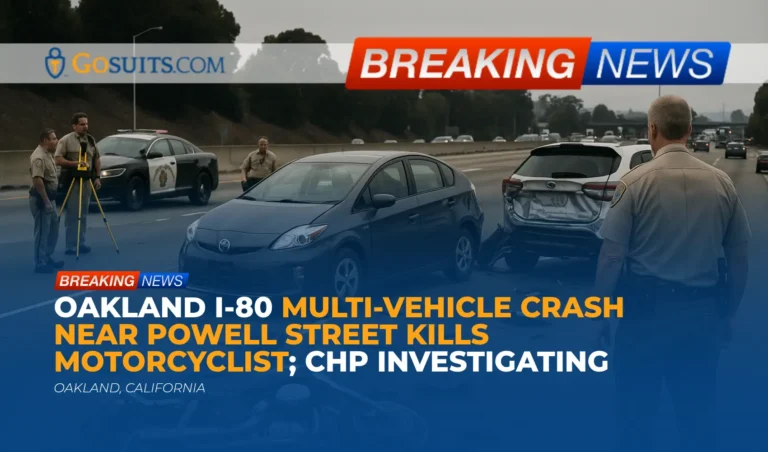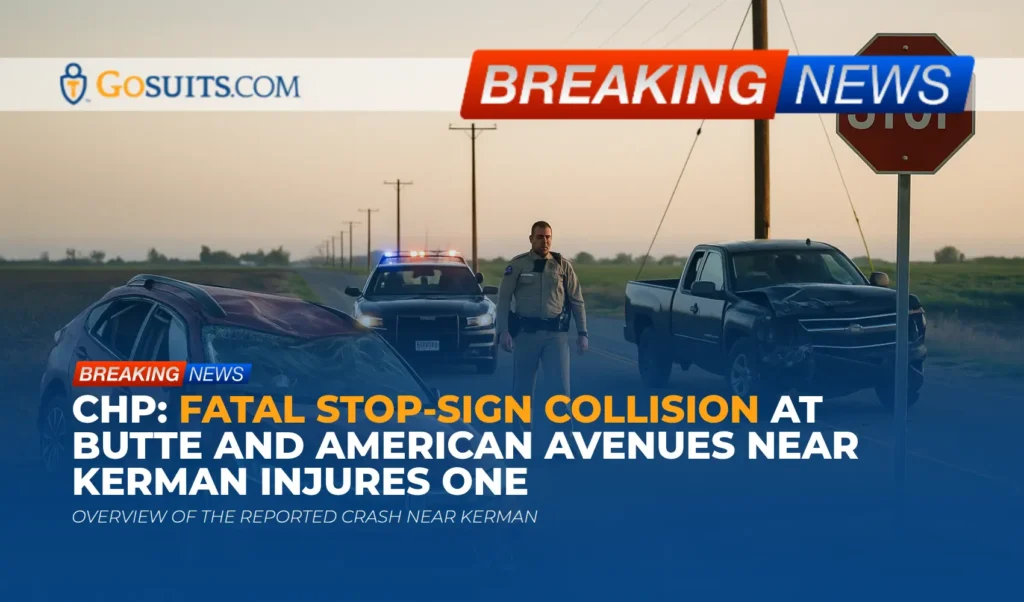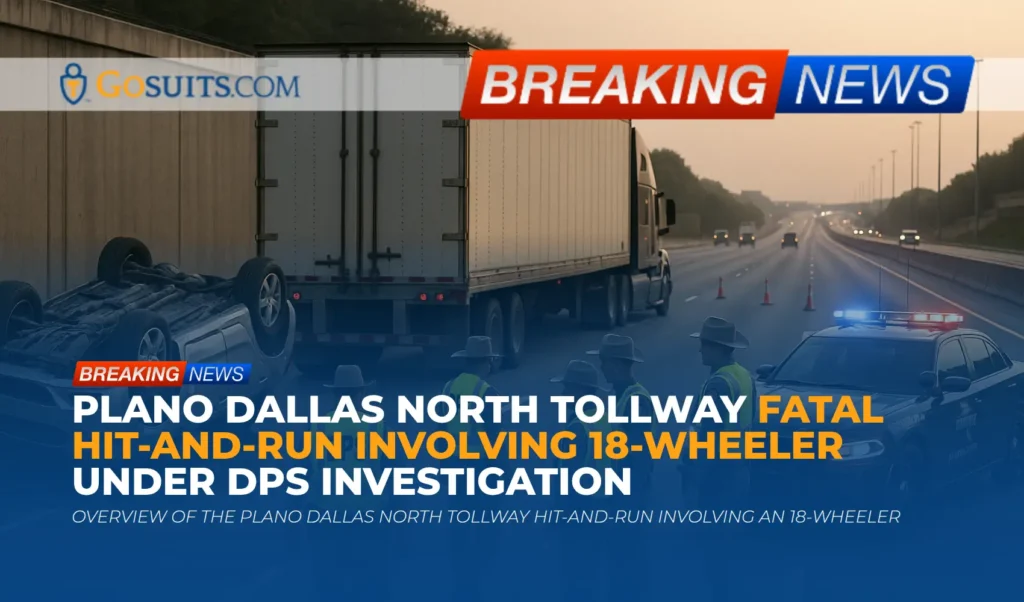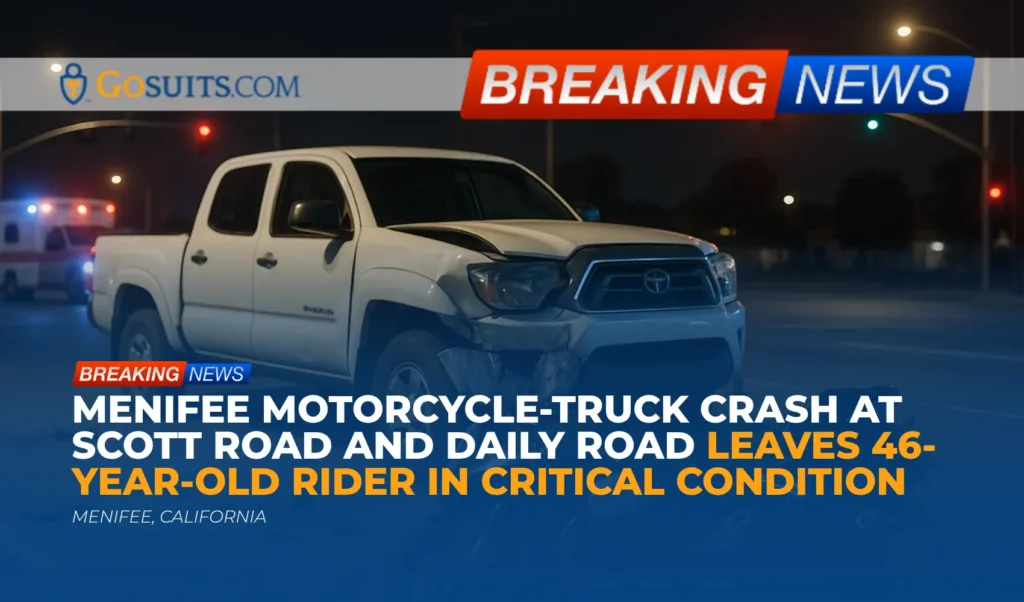- What We Know About the I-80 Multi‑Vehicle Collision in Oakland
- Key Agencies Involved and How to Get Official Information
- Understanding Liability in a Four‑Vehicle Crash Involving a Motorcyclist
- Rights of Families After a Fatal Motorcycle Crash in California
- Evidence to Preserve and Why It Matters
- Insurance Considerations After a Fatal Crash
- Safety and Context: Motorcyclist Risk and California Law
- Practical Steps in the First Days and Weeks
- Why Taking Timely Action Matters
- Commentary from Gosuits Oakland, California Personal Injury Attorney
What We Know About the I-80 Multi‑Vehicle Collision in Oakland
On a Sunday afternoon, around 2:30 p.m., a four‑vehicle collision occurred on eastbound I‑80 west of Powell Street in Oakland. According to early statements attributed to the California Highway Patrol (CHP) Oakland Area office, the vehicles involved were a Honda VT motorcycle, a Toyota Prius, a Tesla Model S, and a Subaru Crosstrek. Tragically, the rider of the Honda motorcycle died at the scene.
CHP indicated that alcohol and drugs were not suspected at the time of the initial assessment. The incident prompted the closure of lanes 1, 2, and 3 while responders secured the scene and conducted the preliminary investigation. All involved drivers remained at the location and cooperated with authorities. The official cause of the crash has not yet been determined, and CHP’s investigation remains active.
Because the collision involved multiple vehicles and resulted in a fatality, investigative steps may include roadway measurements, vehicle inspections, witness interviews, and review of any available video or electronic data. Families and community members should expect that updates from CHP may be limited until the investigation develops further findings.
Key Agencies Involved and How to Get Official Information
California Highway Patrol – Oakland Area Office
CHP is the primary agency investigating collisions on California freeways. For this crash, the Oakland Area Office is responsible. To request the official Traffic Collision Report (often called the CHP 555), eligible parties such as next of kin, involved drivers, and legal representatives can submit a request. CHP provides guidance and a standardized request form (CHP 190) for obtaining reports. See CHP’s instructions on requesting a collision report at chp.ca.gov. You may also find the local office page for contact details at CHP Oakland Area Office.
What to have ready when requesting a report: date and time of the collision, exact or approximate location (eastbound I‑80 west of Powell Street), names of involved parties if known, and the incident or report number if provided by the investigating officer. CHP may require proof of identity and eligibility to receive the report.
Alameda County Coroner’s Bureau
When a death occurs as the result of a crash, the county coroner determines the cause and manner of death, and may conduct an autopsy depending on circumstances. In Alameda County, the Coroner’s Bureau is part of the Sheriff’s Office. Information about the process, how next of kin are notified, and how to request autopsy or investigative reports is available at the county’s website: acgov.org.
Families can typically request copies of the coroner’s report when it is complete. Processing times vary based on investigative needs, laboratory testing, and caseload. Coroner records are distinct from death certificates; both can be important for legal and insurance purposes.
Death Certificates – Alameda County Clerk‑Recorder
Certified death certificates are issued by the county’s Clerk‑Recorder. These records are essential for many administrative processes, including insurance claims and estate matters. For instructions on obtaining a death certificate in Alameda County, see the Clerk‑Recorder’s site at acgov.org.
Public Records and Timelines
Some materials associated with a crash investigation may be available through the California Public Records Act, Government Code section 6250 et seq. Guidance on public records requests is governed by that law, though certain investigative records may be exempt until the investigation is closed. The statute text is accessible at leginfo.legislature.ca.gov.
Understanding Liability in a Four‑Vehicle Crash Involving a Motorcyclist
Determining civil liability in a multi‑vehicle highway collision is fact‑specific. Investigators and, later, insurance adjusters and courts look at how each driver behaved relative to California traffic laws and the circumstances on the road. In a complex crash, multiple drivers can share fault to varying degrees. California applies comparative fault principles, meaning responsibility and recoverable damages can be apportioned among the parties. The Judicial Council’s civil jury instructions describe how comparative fault operates in civil cases in California; see the Judicial Branch resources for jury instructions on comparative negligence at courts.ca.gov.
Key traffic rules that often factor into freeway collisions
While the cause of this crash has not been determined, common California Vehicle Code provisions that investigators analyze in freeway multi‑vehicle collisions include:
- Following distance: Drivers must not follow another vehicle more closely than is reasonable and prudent. See Vehicle Code section 21703 at leginfo.legislature.ca.gov. Chain‑reaction crashes often scrutinize whether motorists maintained adequate spacing for traffic and conditions.
- Basic speed law: No person may drive at a speed greater than is reasonable or prudent given traffic, weather, visibility, and roadway conditions, even if within the posted speed limit. See Vehicle Code section 22350 at leginfo.legislature.ca.gov.
- Lane changes and movements: A vehicle may not turn or move right or left upon a roadway until it is reasonably safe and only after giving an appropriate signal. See Vehicle Code section 22107 at leginfo.legislature.ca.gov.
- Lane splitting context: California recognizes lane splitting. The statute defines lane splitting but does not assign fault; safety depends on speed and conditions. See Vehicle Code section 21658.1 at leginfo.legislature.ca.gov. CHP has published general safety information on lane splitting as well.
It is important not to assume any specific violation or fault without the investigative findings. Even where multiple vehicles are involved, a thorough reconstruction can reveal whether a single unsafe maneuver, abrupt braking, distracted driving, or other factor triggered the sequence. In cases with advanced driver‑assistance systems, investigators may also consider whether any automation was engaged and how the system performed.
Shared fault and recoveries
California’s comparative fault framework allows an injured party, or in a fatal case the decedent’s eligible heirs, to pursue civil claims even if the decedent or claimant shares some percentage of responsibility. Any award can be reduced by the percentage of fault attributed to that person under the court’s or jury’s findings. This is a general principle reflected in California civil jury instructions on comparative negligence, available from the Judicial Council at courts.ca.gov.
Rights of Families After a Fatal Motorcycle Crash in California
After a fatal traffic collision, two types of civil claims are commonly discussed in California: wrongful death claims brought by eligible heirs, and survival actions brought by the decedent’s estate. The applicability and scope of each depends on the facts and on California statutes.
Wrongful death claims
California Code of Civil Procedure section 377.60 identifies who may bring a wrongful death action, typically certain family members. The statute is available at leginfo.legislature.ca.gov. Damages in a wrongful death action may include the loss of the decedent’s financial support, household services, and the loss of love, companionship, comfort, and guidance. The Judicial Council’s civil jury instructions describe categories of wrongful death damages; see CACI resources at courts.ca.gov.
Survival actions
Separate from wrongful death, a survival action allows the decedent’s estate to recover certain losses the decedent sustained before death. This arises under California Code of Civil Procedure sections 377.30 and 377.34, accessible at 377.30 and 377.34. The types of recoverable damages differ from wrongful death claims and are defined by statute.
Time limits
California sets strict filing deadlines. For most personal injury and wrongful death claims, the general statute of limitations is two years from the date of the incident under Code of Civil Procedure section 335.1, available at leginfo.legislature.ca.gov. If any claim involves a public entity, such as a roadway defect claim against a governmental agency, a written government claim usually must be filed within six months under Government Code section 911.2, accessible at leginfo.legislature.ca.gov. Claims alleging a dangerous condition of public property are governed by Government Code section 835, which outlines the elements of liability; the statute is at leginfo.legislature.ca.gov.
Because deadlines can be short and exceptions limited, it is prudent to evaluate potential civil claims as early as possible to avoid missing required timelines.
Evidence to Preserve and Why It Matters
In multi‑vehicle collisions, evidence can be dispersed among several drivers, agencies, and businesses. Preserving it early helps ensure a clear picture of what happened.
Official reports and scene documentation
- Traffic Collision Report: Request the CHP report and any related diagrams or supplements. Guidance to request is at chp.ca.gov.
- Coroner documents: Families can request the coroner’s report and, where applicable, autopsy findings from Alameda County. See acgov.org.
- Death certificate: Obtain certified copies from the Clerk‑Recorder, acgov.org.

Electronic data and recordings
- Event Data Recorders (EDRs): Many vehicles record pre‑crash data such as speed, braking, and seatbelt status. The National Highway Traffic Safety Administration provides information on EDRs at nhtsa.gov. This data may be overwritten or lost if a vehicle is repaired or salvaged, so a prompt preservation request to the vehicle owner or insurer can be crucial.
- Dashcams and in‑car video: Ask all involved drivers and nearby motorists or businesses for copies. Time windows for automatic overwriting can be short.
- Traffic cameras and 911 audio: Some agencies retain footage or audio for limited periods. Access may be governed by the California Public Records Act, Government Code section 6250 et seq., referenced at leginfo.legislature.ca.gov.
Physical evidence
- Motorcycle and safety gear: Preserve the motorcycle in its post‑crash condition and retain the helmet, jacket, and other protective gear. Impact marks and fractures can corroborate impact forces and directions.
- Personal items: Keep damaged clothing, electronics, and any items that may contain data, such as GPS devices.
- Roadway evidence: Photographs of skid marks, debris fields, and lane closures can fade quickly due to traffic and weather. Early scene photographs, even from later the same day, can be valuable.
CHP specialized investigations
When collisions involve fatalities or complex dynamics, CHP may utilize or consult with specialized teams, such as Multidisciplinary Accident Investigation Teams (MAIT). These teams can conduct detailed reconstructions. Information about MAIT appears on CHP’s program services pages at chp.ca.gov. Not every fatal crash receives a MAIT deployment, but the possibility underscores why preserving all available data is important.
Insurance Considerations After a Fatal Crash
Insurance issues arise quickly after a fatal collision, and early decisions can affect the outcome of claims. Each vehicle’s insurer will evaluate liability and coverage, and there may be multiple policies in play.
Common coverage types that may be implicated
- Liability coverage: Pays for bodily injury or property damage the insured is legally responsible for, up to policy limits. In multi‑vehicle collisions, several liability policies may respond based on fault allocations.
- Uninsured/Underinsured Motorist (UM/UIM): If an at‑fault driver lacks adequate insurance, UM/UIM coverage on the decedent’s or a household policy may apply in some cases. Applicability depends on policy language and facts.
- Medical payments (Med‑Pay): Some policies provide limited, no‑fault benefits for medical or funeral expenses.
- Property damage and towing: Collision and comprehensive coverage may address vehicle storage, towing, and damage to the motorcycle or other vehicles.
Recorded statements and early contacts
Insurance adjusters often seek recorded statements soon after a crash. What is said can be used later in ways that affect fault assessments and damage evaluations. It is generally prudent to speak with a qualified attorney before giving any recorded statement to an insurer. Even in straightforward situations, small uncertainties or misstatements can be misinterpreted.
Commercial and employer policies
If any driver was operating a vehicle for work at the time, commercial or employer liability coverage could be implicated under agency principles. Sorting out employer involvement, scope of employment, and coverage tiers requires careful document review.
Safety and Context: Motorcyclist Risk and California Law
Motorcyclists face unique risks on high‑speed, multi‑lane freeways. Visibility, speed differentials, sudden lane changes, and congested traffic common to I‑80 corridors all elevate the need for prudent driving by every road user. National data underscore the vulnerability of riders. The National Highway Traffic Safety Administration provides research and safety resources on motorcyclist fatalities and injury patterns at nhtsa.gov.
Helmet requirement
California requires riders and passengers to wear U.S. DOT‑compliant helmets. This is codified in Vehicle Code section 27803, available at leginfo.legislature.ca.gov. Helmet use is one of the most effective measures to reduce head injuries, though even with a helmet, severe forces in multi‑vehicle freeway collisions can be unsurvivable.
Lane splitting
California’s Vehicle Code recognizes lane splitting, defined in section 21658.1 at leginfo.legislature.ca.gov. Lane splitting itself is not automatically negligent or careless. Whether it is done safely depends on speed, traffic flow, and spacing. CHP has issued safety guidance to help riders and drivers share the road more safely, and all motorists are expected to make safe lane changes and maintain appropriate following distances.
Practical Steps in the First Days and Weeks
After a fatal freeway collision, families often face immediate responsibilities while still processing shock and grief. The following practical considerations can help organize what needs to be done without rushing to conclusions about fault.
Within the first week
- Identify the CHP report number: If available, note the incident or report number and the investigating officer’s name. Request the collision report when it becomes available through CHP’s process at chp.ca.gov.
- Coordinate with the coroner: Stay in contact with the Alameda County Coroner’s Bureau regarding release of remains, autopsy status, and obtaining the coroner’s report. Information is at acgov.org.
- Preserve vehicles and data: Ask that all involved vehicles remain preserved until an independent inspection can occur. Send written requests to owners and insurers to preserve EDR data, dashcam footage, and telematics. Reference NHTSA’s EDR resources at nhtsa.gov if needed.
- Collect witness details: Gather names, phone numbers, and any statements from witnesses who have reached out. Capture any photos or videos shared by bystanders.
- Avoid early recorded statements: Before speaking with any insurance company about the facts, consult an attorney. Statements given without guidance can be used later and can affect fault determinations.

Over the next several weeks
- Obtain death certificates: Order multiple certified copies through the Alameda County Clerk‑Recorder at acgov.org for use in administrative and insurance processes.
- Track expenses: Keep organized records of funeral and burial costs, counseling, time off work, and other expenses. These may be relevant to claims.
- Document relationships and support: In a wrongful death context, documentation of the decedent’s contributions to household services, caregiving, and financial support can be significant.
- Review insurance policies: Identify all potential policies, including the decedent’s motorcycle policy, household auto policies, and any employer‑related coverage.
- Consider roadway conditions: Note any unusual hazards such as missing signage, pavement defects, or poorly marked construction. If a public property issue is suspected, be mindful of the six‑month government claim deadline under Government Code section 911.2 at leginfo.legislature.ca.gov.
Why Taking Timely Action Matters
Time can change the evidence picture. Vehicles are repaired or salvaged, electronic data can be overwritten, and memories fade. Acting promptly can preserve crucial facts and keep options open.
- What should be done: Obtain official records; preserve vehicles and electronic data; organize photos, videos, and witness contacts; and speak with a qualified attorney before engaging with insurers.
- Benefits of acting now: Early preservation captures perishable evidence like EDR data and dashcam footage. Prompt requests to CHP, the coroner, and other custodians establish a clear record trail. Avoiding premature recorded statements helps prevent misunderstandings that could affect liability assessments.
- Why it matters: California’s deadlines are strict. The general two‑year statute in Code of Civil Procedure section 335.1 and the six‑month government claim requirement in Government Code section 911.2 are unforgiving. Early action helps ensure that all potential avenues—whether against private drivers, companies, or public entities—are evaluated before deadlines pass.
- When to act: Immediately for preservation letters and requests to agencies; within days to identify all insurers and potential witnesses; and steadily over the next weeks to compile documents, obtain certified death certificates, and coordinate inspections.
Commentary from Gosuits Oakland, California Personal Injury Attorney
Our hearts are with the family and loved ones affected by this devastating crash on I‑80. A sudden loss on a familiar roadway leaves questions, grief, and an urgent need for clear information. This commentary is intended for educational and general informational purposes to help the community understand what typically happens after a fatal multi‑vehicle collision and what rights may be available under California law.
Based on what is publicly reported so far, CHP is still determining the cause, alcohol and drugs were not initially suspected, multiple lanes were closed for the response, and all involved drivers remained at the scene and cooperated. In four‑vehicle collisions, fault can be complex and may involve several contributing acts or omissions. Investigators often look closely at following distance, lane changes, speed for conditions, and whether any sudden or unsafe movements set off a chain reaction. Because motorcycles are small and more vulnerable, even a momentary lapse by another motorist can have catastrophic consequences for a rider.
Insurance companies and large corporations often move quickly after a serious crash. Adjusters may ask for recorded statements, request authorizations, or suggest early settlements before the full scope of fault and losses is understood. This can take advantage of the information gap families face in the aftermath of a tragedy. Statements can be used later to dispute liability or minimize damages. Access to the vehicles, EDR data, dashcam footage, and independent inspections may be delayed unless specifically demanded. Understanding these dynamics helps level the playing field.
A free consultation with a seasoned attorney provides an opportunity to discuss the facts, the investigative process, and deadlines without any obligation. It can help clarify whether to request certain records now, how to preserve evidence, and how to handle insurance communications. Before speaking with any insurer, it is wise to understand rights under California law and how what is said might be used later.
Select Legal and Government Resources Referenced
- California Highway Patrol – Requesting a Copy of a Collision Report
- CHP Oakland Area Office
- Alameda County Coroner’s Bureau
- Alameda County Clerk‑Recorder (Vital Records)
- NHTSA – Motorcycle Safety
- NHTSA – Event Data Recorder (EDR)
- California Judicial Branch – Civil Jury Instructions (Comparative Fault and Wrongful Death)
- California Vehicle Code § 21703 (Following Too Closely)
- California Vehicle Code § 22350 (Basic Speed Law)
- California Vehicle Code § 22107 (Turning and Lane Changing)
- California Vehicle Code § 21658.1 (Lane Splitting)
- California Vehicle Code § 27803 (Helmet Requirement)
- California Code of Civil Procedure § 377.60 (Wrongful Death)
- California Code of Civil Procedure § 377.30 (Survival Actions)
- California Code of Civil Procedure § 377.34 (Damages in Survival Actions)
- California Code of Civil Procedure § 335.1 (Two‑Year Statute of Limitations)
- California Government Code § 911.2 (Government Claims Deadline)
- California Government Code § 835 (Dangerous Condition of Public Property)
- California Public Records Act (Gov. Code § 6250 et seq.)
- CHP – Multidisciplinary Accident Investigation Teams (MAIT)






